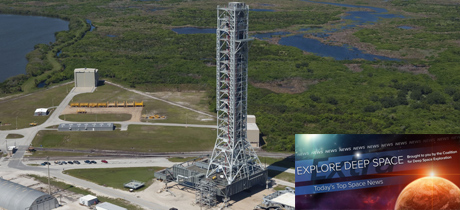In Today’s Deep Space Extra… NASA contracts for a key piece of ground hardware at NASA’s Kennedy Space Center (KSC) to support an accelerated and sustainable human return to the lunar surface. Spike in Mars methane concentration continues to intrigue. Israel’s Space IL will not attempt a lunar return after all. Remembering Apollo 11.
Human Space Exploration
Today’s tidbits: June 25, 2019: NASA awards Mobile Launcher 2 contract
Spacepolicyonline.com (6/26): As urged by Congress, NASA is acquiring a second Mobile Launcher (ML) for the Space Launch System (SLS) heavy lift rocket, a cornerstone in efforts to resume human deep space exploration with an accelerated landing at the south pole of the Moon in 2024. The SLS will be assembled or “stacked” on the ML platform in the Kennedy Space Center’s (KSC) Vertical Assembly Building (VAB) for transportation to the launch pad. The first ML platform was developed for the SLS block 1, which will launch the first uncrewed and crewed test flights of the SLS and Orion, called Artemis 1 and 2. Under an approximate $383 million contract announced Tuesday, Bechtel National, Inc., of Reston, Virginia, will build a second platform equipped for the SLS block 1B, with a more powerful upper stage. That’s the launch vehicle for Artemis 3, which is to launch the first woman and next male astronaut to the Moon in 2024 and after that help to establish a sustainable human presence.
Space Science
Mars released a puff of gas. Now the gas is past
New York Times (6/25): Mission scientists say they are baffled. Last week, NASA’s Curiosity rover, which has been exploring Gale Crater on Mars since it landed in August 2012, detected an unusually high level of methane gas in the Red Planet’s thin atmosphere, 21 parts per billion. On Earth, methane production is linked to microbial activity. A quick repeat of the rover’s sensor readings over the weekend revealed a dramatic drop in the concentration, less than 1 part per billion, or more typical. Methane is also produced by volcanism and other geological processes, though Mars currently is not volcanically active. Other spacecraft at Mars may help resolve the mystery.
Asteroid that’s 3 times as long as a football field will whiz by Earth Thursday
Space.com (6/25): Three times the length of a football field, the asteroid 2008 KV2 is to rush by the Earth on Thursday at a range of 4.2 million miles. Thank goodness, 2008 KV2 is a big one and will be back this way in 2021 and 2022.
A new algorithm finds nearby stars that could host hidden worlds
Science News (6/25): A new algorithm used by scientists at the Southwest Research Institute of San Antonio has bolstered an extra solar planet search that suggests nearby stars may host more planets that initially apparent. The software takes a closer look at the chemistry of the stars to expand the probability of more large planets.
Other News
SpaceIL: Beresheet won’t attempt Moon landing, will seek another challenge
Jerusalem Post (6/26): In April, Israel’s first attempt at the landing of a spacecraft on the Moon failed in the final moments. Space IL, the team behind the largely privately funded effort, pledged to try again in the aftermath. However, the nonprofit initiative announced Wednesday that it is now in search of another, also inspiring goal.
NASA selects partners for Mars 2020 ‘Name the Rover’ contest, seeks judges
NASA/Jet Propulsion Laboratory (6/25): NASA is preparing its Mars 2020 rover for a mid-2020 launch and a February 2021 landing at the Red Planet’s Jezero Crater. The rover is to look for evidence of past microbial life on Mars and cache samples of rock and soil for return to Earth. The bold mission needs a name, and NASA is asking students in K-12 to compete. The agency has enlisted Battelle Education, of Columbus, Ohio, and Future Engineers, of Burbank, California, to assist with a competition that will get underway in the Fall.
Apollo 11
Was Apollo 11 a beginning or an end?
Texas Monthly (July 2019): A look back at the 1960’s, the JFK presidency and especially the role his assassination may have played in ensuring the financial commitment required for NASA to reach the moon with the Apollo explorers. The 50th anniversary of Apollo 11, the first Moon landing by humans, is approaching on July 20, amid efforts by the White House to engineer an accelerated return in 2024 to help the U.S. prepare for the human exploration of Mars and other deep space destinations.
Will the work be remembered? One member of the Lunar Module team reflects
Newsday (6/25): Lunar module assembler Peter Giargente reflects on the work at Grumman on New York’s Long Island more than a half century ago that helped make it possible for NASA astronauts to land and live briefly on the surface of the Moon during six of the Apollo missions between 1969 and 1972.
The evolution of NASA’s spacesuits: ‘A spacecraft in the shape of a human’
Houston Chronicle (6/25): Complex and intended to protect the safety of the astronauts from Mercury to Apollo, the space shuttle and the International Space Station (ISS), NASA’s space suits are evolving again as NASA prepares to resume human deep space exploration.

